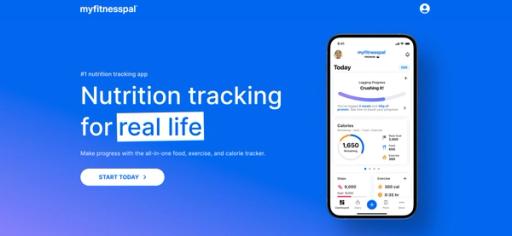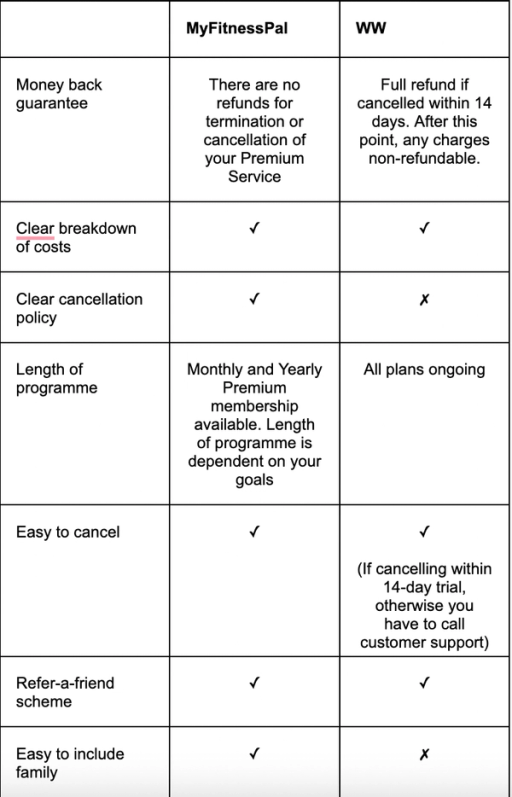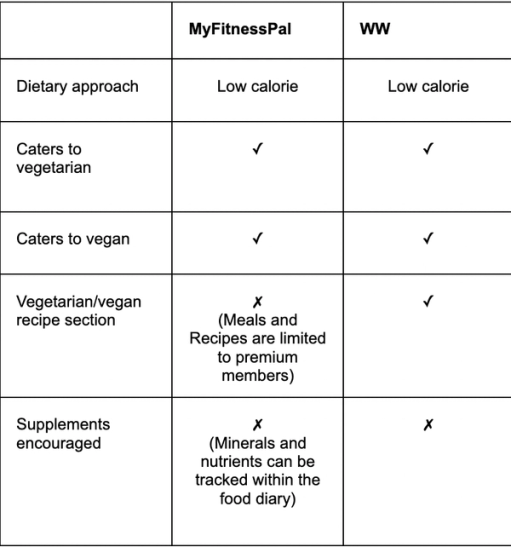
Keeping track of what you eat can feel daunting when losing weight. Maybe you’ve tried several methods, but none helped you reach your goals. Now, you’re ready to find a more organized approach to tracking calories and nutrients so you can get on with your weight loss journey. As you consider your options for best app to track macros, you keep hearing about two popular names: Weight Watchers and MyFitnessPal. What's the difference? Which plan might work better for you? This article on Weight Watchers vs MyFitnessPal will walk you through key similarities and differences to help you confidently choose the best weight loss tool tailored to your lifestyle, preferences, and goals for achieving lasting success.
Cal AI's calorie tracker can help you achieve your objectives by providing personalized features that adapt to your unique preferences and circumstances.

Weight Watchers (WW) is today's most popular weight loss program. The program uses a point-based system to track food intake and build healthy eating habits. Rather than restricting or eliminating any type of food, this system allows users to structure their diet according to their preferences so long as the total number of points falls within a pre-set range.
For many, this straightforward, numbered system helped to simplify the weight loss process and provide short-term improvements in overall health.
Despite its benefits, Weight Watchers does little to teach users the “why” behind its points system or provide the well-rounded knowledge necessary for long-term results. Because of these failings, many users regain much of the weight lost after discontinuing Weight Watchers.
The Bottom Line: For its price point, Weight Watchers is an effective educational tool for developing essential, healthy eating habits. Its tracking features are well-built and intuitive, but a lack of in-depth, customizable education requires users to remain dependent on its services rather than building a lifelong understanding of nutrition.

Weight Watchers bases its service on a personalized points system. When signing up, you must enter personal information such as:
The program will then assign you a daily and weekly points budget to “spend” on different foods.
In the Weight Watchers app, each food is assigned a point value based on its nutritional value and impact on your weight loss journey. Some foods are zero points and can be eaten as often as you’d like. Less “healthy” foods, such as those high in refined sugars or saturated fats, cost more points.
Throughout the day, Weight Watchers customers log each of their meals into their app. With each point spent, the application updates your “budget” and provides a clear readout of how many points you have left for the day. Weight Watchers sets a weekly point budget at the beginning of each new week.
This feature allows users to move points from one day to another for special occasions, such as a dinner out with family.
Weight Watchers adds flexibility and clarity to any weight loss journey. And, because no food is off-limits, users can enjoy treats without feeling like they’ve ruined their diet. This realistic approach to weight loss is what we like best about the platform: rather than restricting your diet, Weight Watchers promotes healthy habits by setting a reasonable points budget. If you want to enjoy a dessert with a high point value, you can focus on zero-point foods throughout the day to balance it out and stay within your budget. Plus, you can apply part of your weekly points budget to that day for extra wiggle room.
We also love the social nature of Weight Watchers. It’s challenging to lose weight, especially without a community to support your efforts. Luckily, Weight Watchers’ premium subscription provides you with a personal coach and allows you to attend in-person or virtual workshops.

MyFitnessPal is a free exercise- and nutrition-tracking program incorporating social media elements. Each time users eat or exercise, they log related details into the app’s pages. Although one of the most basic forms of weight loss tool available, MyFitnessPal’s tracking app is well-designed and easy to use, with a simple premise: by tracking your habits, you can see what you’re doing well and where you need to improve. The app’s social media aspects also help promote community and accountability by connecting you to other fitness-minded people. You can find tips and advice from other users by liking and commenting on any other social media platform.
The Bottom Line: MyFitnessPal is a simple app that leverages the power of community to tackle the nutrition and exercise aspects of healthy living. Its free version is well-built and convenient but lacks many features that are common to more compelling, comprehensive services.
After you log personal information similar to that Weight Watchers require, MyFitnessPal recommends a daily net calorie target to help you reach your target weight. After this short setup, users log their meals into the app daily.
One of MyFitnessPal’s most convenient features is its ability to remember meals from previous days, meaning that the longer you track, the easier it gets to add your favorite meals. The app includes a section for tracking exercises, which it sorts by type and duration. By tracking the number of calories consumed and the amount of exercise performed each day, MyFitnessPal calculates your net calories for the day.
Unlike Weight Watchers’ more rigid daily calorie limit, MyFitnessPal’s calorie recommendations vary daily depending on your activity level. MyFitnessPal recommends recording your weight weekly so your goals can accurately reflect your needs.
We love that MyFitnessPal has a free option and seems genuinely dedicated to helping people build healthy eating habits. Although the free version of the app is relatively basic, its features allow you to test food and exercise tracking to determine whether it is helpful for you without locking you into a subscription. Food tracking is simple with MyFitnessPal. After you log the same food repeatedly, the app will remember it and allow you to add it more quickly in the future. The premium version also allows you to scan an item’s barcode to input all necessary nutritional information immediately.
Fitness tracking is even easier with an exercise tracker like an Apple Watch or Fitbit. You can connect these devices to your plan to automatically input your workouts and calories burned. Social media networks are very beneficial. Users motivate each other to continue working toward their goals with online support and tips.

Note: When signing up for a free or premium account with MyFitnessPal, Inc. they transfer your data to the US. It’s important to note that US laws may be less protective than those of your home country/region.
MyFitnessPal and Weight Watchers help users create a calorie deficit to lose weight. With MyFitnessPal, you log your meals and exercise to calculate the calories you’ve consumed and burned. Weight Watchers count calories for you through their unique points system. Both programs also feature an easy-to-use daily food diary.
Keeping track of your food intake is simple, as both programs ask you to record everything you eat in your daily food diary. You can view the nutritional content for every meal you eat, either in terms of calories and macronutrients or through WW’s points system. MFP and WW ask for:
The apps then use this data to create a recommended calorie intake or points target personalized to your unique weight loss needs.
Both MyFitnessPal and Weight Watchers have their own online member communities. Whether you’re just starting your weight loss journey or simply need some extra motivation, members can:

MyFitnessPal and Weight Watchers help you work toward similar outcomes, i.e., reaching your weight and wellness goals. Nevertheless, they have some key differences. Keep reading to discover these differences to help you determine the best product for your needs.
MyFitnessPal is all about counting calories, with an extensive food database that asks you to enter all of your food and drinks manually. Instead, Weight Watchers focuses on nutrition data, using a points-based system to meet your unique nutrition needs based on age, height, and current weight.

MFP allows users to quickly discover the content of foods, including carbs, sugars, fiber, protein, and calories. WW focuses on educating users on how food intake affects their bodies differently, without focusing directly on teaching users how to create a calorie deficit.
Whereas MyFitnessPal provides users with the tools for calorie counting alone, those using Weight Watchers are supported through their weight loss by expert coaches.
Another noteworthy difference is that MyFitnessPal is purely an app, whereas you can follow the Weight Watchers weight loss program without the WW app. You also have the option to meet up with the Weight Watchers group in person and online to measure lost weight and monitor your progress.
Both programs offer benefits to users. With a mission to support you in making healthy choices regarding your diet, you can expect to improve your health with either of these apps. Still, it’s worth reviewing the primary advantages to see how they will deliver.
The first thing to note is that recording what you eat daily is easy, with more than 14 million foods in the MyFitnessPal database. You can quickly go into the app and add your meals for the day, with plenty of options to ensure accuracy. For example, you will find a list of brands when you search for a food item.
Making a calorie deficit (burning more calories than you consume) is an optimal strategy to lose weight, which is what MFP focuses on. You can quickly assess the number of calories in foods, and with a daily target, you can easily see whether you need to eat more or fewer calories to reach your weight loss goals.
The Weight Watchers diet plan offers similar benefits by gradually encouraging you to lose weight through a balanced diet. Losing weight slowly and steadily is always recommended to remain healthy and mitigate future weight gain. It prioritizes nutrition rather than restricting calories and banning foods.
Many people enjoy the social aspect of the WW platform. You can join a community of people on weight loss journeys similar to your own and share advice, tips, and motivational strategies. Knowing you have community support can help you stay on track and lift your spirits when feeling defeated.
No health plan is perfect, and not everyone will have the same experience when using a particular app. You should consider the disadvantages before purchasing a subscription or committing your time to a platform. Many users have reported experiencing tech issues with MyFitnessPal. For example, some report problems when using the barcode scanning tool. It can only sometimes find the exact product you’re looking for, which can become frustrating and time-consuming.
Although the food database is extensive, it is not 100% accurate. It has gradually grown with the help of MyFitnessPal customers, meaning there is always room for possible mistakes thanks to human error. So, you cannot count on this app for complete and utter accuracy. It’s excellent that Weight Watchers allows you to eat certain foods. The points system allows for a flexible diet, with more freedom to eat what you want for weight loss. Nonetheless, there is no limit on zero-point foods. While foods with zero points are typically low-calorie, this freedom might lead some people to overeat, which can harm your weight loss journey. On the other hand, following WW could potentially result in undereating.
Price is an essential element when choosing a membership plan for losing weight. Improving your health and getting in shape shouldn’t break the bank. You should balance the cost, features, and overall effectiveness. The right platform must fit your budget. A free version of MyFitnessPal is available for those who want a simple device for counting calories, whereas Weight Watchers memberships are all paid. Nevertheless, you’ll need to upgrade to MyFitnessPal Premium to access all features fully. At the time of writing this review, the pricing is as follows: $19.99 per month, $79.99 per year (annual subscription). Unlike MFP, WW has two membership options:
Core allows you to follow the program through the app, whereas Premium lets you attend in-person workshops. The price of WW, therefore, varies depending on the type of program you choose and how long you want to follow it. The current pricing is shown below:

Cal AI transforms calorie tracking with cutting-edge AI technology. Just snap a photo of your meal, and we'll do the rest.
Our app combines your phone's depth sensor with advanced AI models to:
With 90% accuracy on visible foods and multiple tracking options like:
We've made nutrition tracking effortless. Whether you're scanning a full meal or a quick snack, Cal AI
Our AI learns from your feedback to improve accuracy. It includes personalized insights and smart reminders to keep you on track. Cal AI makes achieving your fitness goals simpler than ever.
Track your calories with your camera using Cal AI's calorie tracker today!